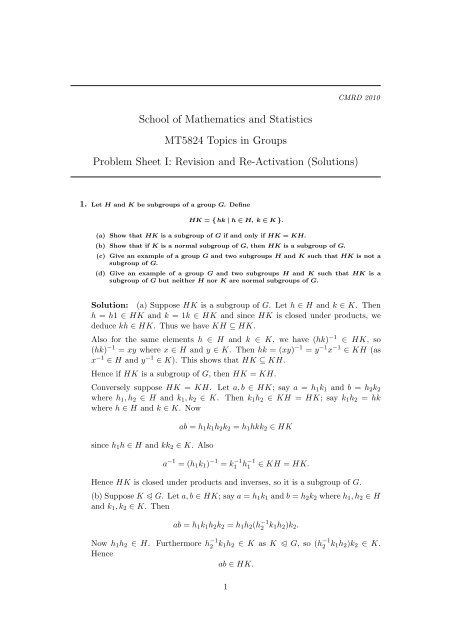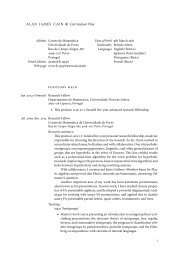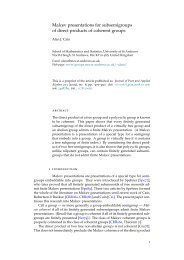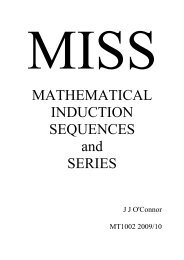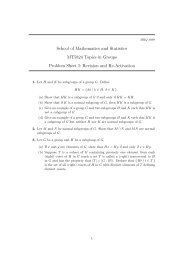School of Mathematics and Statistics MT5824 Topics in Groups ...
School of Mathematics and Statistics MT5824 Topics in Groups ...
School of Mathematics and Statistics MT5824 Topics in Groups ...
Create successful ePaper yourself
Turn your PDF publications into a flip-book with our unique Google optimized e-Paper software.
CMRD 2010<br />
<strong>School</strong> <strong>of</strong> <strong>Mathematics</strong> <strong>and</strong> <strong>Statistics</strong><br />
<strong>MT5824</strong> <strong>Topics</strong> <strong>in</strong> <strong>Groups</strong><br />
Problem Sheet I: Revision <strong>and</strong> Re-Activation (Solutions)<br />
1. Let H <strong>and</strong> K be subgroups <strong>of</strong> a group G. Def<strong>in</strong>e<br />
HK = { hk | h ∈ H, k ∈ K }.<br />
(a) Show that HK is a subgroup <strong>of</strong> G if <strong>and</strong> only if HK = KH.<br />
(b) Show that if K is a normal subgroup <strong>of</strong> G, thenHK is a subgroup <strong>of</strong> G.<br />
(c) Give an example <strong>of</strong> a group G <strong>and</strong> two subgroups H <strong>and</strong> K such that HK is not a<br />
subgroup <strong>of</strong> G.<br />
(d) Give an example <strong>of</strong> a group G <strong>and</strong> two subgroups H <strong>and</strong> K such that HK is a<br />
subgroup <strong>of</strong> G but neither H nor K are normal subgroups <strong>of</strong> G.<br />
Solution: (a) Suppose HK is a subgroup <strong>of</strong> G. Let h ∈ H <strong>and</strong> k ∈ K. Then<br />
h = h1 ∈ HK <strong>and</strong> k =1k ∈ HK <strong>and</strong> s<strong>in</strong>ce HK is closed under products, we<br />
deduce kh ∈ HK. ThuswehaveKH ⊆ HK.<br />
Also for the same elements h ∈ H <strong>and</strong> k ∈ K, we have (hk) −1 ∈ HK, so<br />
(hk) −1 = xy where x ∈ H <strong>and</strong> y ∈ K. Then hk =(xy) −1 = y −1 x −1 ∈ KH (as<br />
x −1 ∈ H <strong>and</strong> y −1 ∈ K). This shows that HK ⊆ KH.<br />
Hence if HK is a subgroup <strong>of</strong> G, thenHK = KH.<br />
Conversely suppose HK = KH. Let a, b ∈ HK; saya = h 1 k 1 <strong>and</strong> b = h 2 k 2<br />
where h 1 ,h 2 ∈ H <strong>and</strong> k 1 ,k 2 ∈ K. Then k 1 h 2 ∈ KH = HK; sayk 1 h 2 = hk<br />
where h ∈ H <strong>and</strong> k ∈ K. Now<br />
s<strong>in</strong>ce h 1 h ∈ H <strong>and</strong> kk 2 ∈ K. Also<br />
ab = h 1 k 1 h 2 k 2 = h 1 hkk 2 ∈ HK<br />
a −1 =(h 1 k 1 ) −1 = k −1<br />
1 h−1 1 ∈ KH = HK.<br />
Hence HK is closed under products <strong>and</strong> <strong>in</strong>verses, so it is a subgroup <strong>of</strong> G.<br />
(b) Suppose K G. Let a, b ∈ HK;saya = h 1 k 1 <strong>and</strong> b = h 2 k 2 where h 1 ,h 2 ∈ H<br />
<strong>and</strong> k 1 ,k 2 ∈ K. Then<br />
ab = h 1 k 1 h 2 k 2 = h 1 h 2 (h −1<br />
2 k 1h 2 )k 2 .<br />
Now h 1 h 2 ∈ H. Furthermore h −1<br />
2 k 1h 2 ∈ K as K G, so(h −1<br />
2 k 1h 2 )k 2 ∈ K.<br />
Hence<br />
ab ∈ HK.<br />
1
Also<br />
a −1 = k −1<br />
1 h−1 1 = h −1<br />
1 (h 1k −1<br />
1 h−1 1 )<br />
<strong>and</strong> here h 1 k1 −1 h−1 1 =(k1 −1 )h−1 1 is the conjugate <strong>of</strong> the element k1 −1 by the element<br />
h −1<br />
1 so belongs to K. Thus a −1 ∈ HK <strong>and</strong> we have shown that HK is<br />
closed under products <strong>and</strong> <strong>in</strong>verses, so is a subgroup <strong>of</strong> G.<br />
(c) Take G = S 3 , H = (1 2) <strong>and</strong> K = (2 3). Then H <strong>and</strong> K are subgroups<br />
<strong>of</strong> G (each conta<strong>in</strong><strong>in</strong>g two elements) <strong>and</strong><br />
HK = {1, (1 2), (2 3), (1 3 2)}<br />
a set <strong>of</strong> size 4. Therefore HK is not a subgroup <strong>of</strong> G (by Lagrange’s Theorem)<br />
s<strong>in</strong>ce 4 does not divide 6.<br />
(d) Let G = D 8 generated by the permutation α <strong>of</strong> order 4 <strong>and</strong> β <strong>of</strong> order 2. Let<br />
H = α 2 β <strong>and</strong> K = β. ThenH <strong>and</strong> K are subgroups <strong>of</strong> G <strong>of</strong> order 2 <strong>and</strong><br />
HK = {1,β,α 2 β,α 2 }<br />
<strong>and</strong> s<strong>in</strong>ce we can calculate that α 2 commutes with β it is easy to check that<br />
HK is closed under products <strong>and</strong> <strong>in</strong>verses. On the other h<strong>and</strong> neither H nor K<br />
are normal <strong>in</strong> G:<br />
α −1 (α 2 β)α = αβα = β ∈ H<br />
<strong>and</strong><br />
α −1 βα = α 2 β ∈ K.<br />
2. Let M <strong>and</strong> N be normal subgroups <strong>of</strong> G. Show that M ∩N <strong>and</strong> MN are normal subgroups<br />
<strong>of</strong> G.<br />
Solution: The <strong>in</strong>tersection <strong>of</strong> two subgroups is aga<strong>in</strong> a subgroup, so M ∩ N is<br />
a subgroup <strong>of</strong> G. Let x ∈ M ∩ N <strong>and</strong> g ∈ G. Theng −1 xg ∈ M (as x ∈ M G)<br />
<strong>and</strong> similarly g −1 xg ∈ N. Hence g −1 xg ∈ M ∩ N <strong>and</strong> so M ∩ N G.<br />
S<strong>in</strong>ce N G, part (b) <strong>of</strong> Question 1 shows that MN is a subgroup <strong>of</strong> G. Let<br />
x ∈ MN,sayx = mn where m ∈ M <strong>and</strong> n ∈ N. Ifg ∈ G, then<br />
g −1 xg = g −1 mg · g −1 ng ∈ MN<br />
as g −1 mg ∈ M <strong>and</strong> g −1 ng ∈ N. Hence MN G.<br />
3. Let G be a group <strong>and</strong> H be a subgroup <strong>of</strong> G.<br />
(a) If x <strong>and</strong> y are elements <strong>of</strong> G, showthatHx = Hy if <strong>and</strong> only if x ∈ Hy.<br />
(b) Suppose T is a subset <strong>of</strong> G conta<strong>in</strong><strong>in</strong>g precisely one element from each (right) coset<br />
<strong>of</strong> H <strong>in</strong> G (such a set T is called a (right) transversal to H <strong>in</strong> G <strong>and</strong> has the property<br />
that |T | = |G : H|). Deduce that { Ht | t ∈ T } is the set <strong>of</strong> all (right) cosets <strong>of</strong> H<br />
<strong>in</strong> G with dist<strong>in</strong>ct elements <strong>of</strong> T def<strong>in</strong><strong>in</strong>g dist<strong>in</strong>ct cosets.<br />
2
Solution: (a) If Hx = Hy, thenx =1x ∈ Hx = Hy. Conversely suppose<br />
x ∈ Hy. Then x = hy for some h ∈ H <strong>and</strong> so xy −1 = h ∈ H <strong>and</strong> we deduce<br />
Hx = Hy.<br />
(b) If Hx is any coset <strong>of</strong> H <strong>in</strong> G, then by assumption there is some element t ∈ T<br />
with t ∈ Hx <strong>and</strong> by part (a) we have Hx = Ht. Thus{ Ht | t ∈ T } is the set <strong>of</strong><br />
all cosets <strong>of</strong> H <strong>in</strong> G. Suppose Ht = Hu for some t, u ∈ T . Then both t <strong>and</strong> u<br />
belong to Ht (s<strong>in</strong>ce t =1t ∈ Ht <strong>and</strong> u =1u ∈ Hu = Ht) <strong>and</strong> our assumption<br />
on T forces t = u. Thus a transversal to H <strong>in</strong> G parametrises the cosets <strong>of</strong> H <strong>in</strong><br />
a one-one manner.<br />
4. Let G be a (not necessarily f<strong>in</strong>ite) group with two subgroups H <strong>and</strong> K such that K H <br />
G. The purpose <strong>of</strong> this question is to establish the <strong>in</strong>dex formula<br />
|G : K| = |G : H|·|H : K|.<br />
Let T be a transversal to K <strong>in</strong> H <strong>and</strong> U be a transversal to H <strong>in</strong> G.<br />
(a) By consider<strong>in</strong>g the coset Hg or otherwise, show that if g is an element <strong>of</strong> G, then<br />
Kg = Ktu for some t ∈ T <strong>and</strong> some u ∈ U.<br />
(b) If t, t ∈ T <strong>and</strong> u, u ∈ U with Ktu = Kt u ,firstshowthatHu = Hu <strong>and</strong> deduce<br />
u = u ,<strong>and</strong>thenshowthatt = t .<br />
(c) Deduce that TU = { tu | t ∈ T, u ∈ U } is a transversal to K <strong>in</strong> G <strong>and</strong> that<br />
|G : K| = |G : H|·|H : K|.<br />
(d) Show that this formula follows immediately from Lagrange’s Theorem if G is a f<strong>in</strong>ite<br />
group.<br />
Solution: (a) Let g ∈ G. Then Hg is a coset <strong>of</strong> H <strong>in</strong> G, soHg = Hu for<br />
some u ∈ U (s<strong>in</strong>ce U is a transversal). Then g ∈ Hu, sog = hu for some<br />
h ∈ H. Now consider the coset Kh. As T is a transversal to K <strong>in</strong> H, wehave<br />
Kh = Kt for some t ∈ T . Therefore h ∈ Kt so h = kt for some k ∈ K. Then<br />
g = hu = ktu ∈ Ktu <strong>and</strong> we deduce Kg = Ktu.<br />
(b) Suppose Ktu = Kt u . Then tu(t u ) −1 ∈ K, that is tu(u ) −1 (t ) −1 = k for<br />
some k ∈ K. S<strong>in</strong>ce t, t ,k ∈ H, weseeu(u ) −1 = t −1 kt ∈ H <strong>and</strong> we deduce<br />
Hu = Hu . As U is a transversal to H <strong>in</strong> G, we must therefore have u = u .<br />
Therefore t(t ) −1 = k <strong>and</strong> we have Kt = Kt . The fact that T is a transversal<br />
to K <strong>in</strong> H forces t = t .<br />
(c) Part (a) tells us that each coset <strong>of</strong> K <strong>in</strong> G conta<strong>in</strong>s an element tu for some<br />
t ∈ T <strong>and</strong> some u ∈ U. Furthermore part (b) tells us that there is precisely one<br />
choice <strong>of</strong> t <strong>and</strong> one choice <strong>of</strong> u achiev<strong>in</strong>g this. Thus each coset <strong>of</strong> K <strong>in</strong> G conta<strong>in</strong>s<br />
exactly one element from TU; that is, TU is a transversal to K <strong>in</strong> G. Note that<br />
the number <strong>of</strong> cosets <strong>of</strong> K <strong>in</strong> G then equals |T |·|U|; that is,<br />
|G : K| = |U|·|T | = |G : H|·|H : K|.<br />
(d) If G is f<strong>in</strong>ite, Lagrange’s Theorem tells us |G : K| = |G|/|K|, <strong>and</strong> similarly<br />
for the other <strong>in</strong>dices. Thus<br />
|G : H|·|H : K| =(|G|/|H|) · (|H|/|K|) =|G|/|K| = |G : K|.<br />
5. Let G be a group <strong>and</strong> H be a subgroup <strong>of</strong> G.<br />
(a) Show that H is a normal subgroup <strong>of</strong> G if <strong>and</strong> only if Hx = xH for all x ∈ G.<br />
(b) Show that if |G : H| =2,thenH is a normal subgroup <strong>of</strong> G.<br />
3
Solution: (a) Suppose H G. Let h ∈ H. Then x −1 hx ∈ H, sayx −1 hx =<br />
k ∈ H. Thenhx = xk ∈ xH <strong>and</strong> we deduce Hx ⊆ xH.<br />
Equally xhx −1 = h x−1 ∈ H, sayxhx −1 = l ∈ H. Then xh = lx ∈ Hx <strong>and</strong> we<br />
deduce xH ⊆ Hx.<br />
Hence if H G, thenHx = xH for all x ∈ G.<br />
Conversely suppose Hx = xH for all x ∈ G. Let h ∈ H <strong>and</strong> x ∈ G. Then<br />
hx ∈ Hx = xH, sohx = xk where k ∈ H. Thenx −1 hx = k ∈ H <strong>and</strong> we deduce<br />
H G.<br />
(b) Suppose |G : H| = 2. Then G has two right cosets which are necessarily H =<br />
H1 <strong>and</strong> Hg where g ∈ H. Note then that Hg consists <strong>of</strong> all the elements not<br />
<strong>in</strong> H:<br />
Hg = G \ H.<br />
Now consider any left coset xH. Ifx ∈ H, thenxH = H = Hx. Ifx ∈ H, then<br />
xH must be another left coset <strong>of</strong> H <strong>and</strong> this must equal the rema<strong>in</strong><strong>in</strong>g elements<br />
<strong>of</strong> G (s<strong>in</strong>ce the left cosets also partition G <strong>in</strong>to the same number <strong>of</strong> left cosets as<br />
there are right cosets):<br />
Hence, by (a), H G.<br />
xH = G \ H = Hg = Hx.<br />
6. Give an example <strong>of</strong> a f<strong>in</strong>ite group G <strong>and</strong> a divisor m <strong>of</strong> |G| such that G has no subgroup<br />
<strong>of</strong> order m.<br />
Solution: Let G = A 4 . Then 6 divides |A 4 | = 12. Suppose that H is a<br />
subgroup <strong>of</strong> G <strong>of</strong> order 6. Then |G : H| =2soH G.<br />
Consider the quotient group G/H. This has order 2, so (Hx) 2 = H1 for all Hx<br />
<strong>in</strong> G/H. Therefore Hx 2 = H for all x ∈ G; that is, x 2 ∈ H.<br />
Hence H conta<strong>in</strong>s all squares <strong>of</strong> elements <strong>in</strong> A 4 . S<strong>in</strong>ce (αβγ) 2 =(αγβ) for all<br />
choices <strong>of</strong> α, β <strong>and</strong> γ, we deduce that H conta<strong>in</strong>s all 3-cycles. But there are<br />
(4 × 3 × 2)/3 = 8 such 3-cycles <strong>in</strong> A 4 <strong>and</strong> this contradicts |H| = 6.<br />
Thus A 4 has no subgroup <strong>of</strong> order 6.<br />
7. Let G = x be a cyclic group.<br />
(a) If H is a non-identity subgroup <strong>of</strong> G, showthatH conta<strong>in</strong>s an element <strong>of</strong> the form x k<br />
with k>0.<br />
Choose k to be the smallest positive <strong>in</strong>teger such that x k ∈ H. Show that every<br />
element <strong>in</strong> H has the form x kq for some q ∈ Z <strong>and</strong> hence that H = x k . [H<strong>in</strong>t: Use<br />
the Division Algorithm.]<br />
Deduce that every subgroup <strong>of</strong> a cyclic group is also cyclic.<br />
(b) Suppose now that G is cyclic <strong>of</strong> order n. Let H be the subgroup considered <strong>in</strong><br />
part (a), so that H = x k where k is the smallest positive <strong>in</strong>teger such that x k ∈ H,<br />
<strong>and</strong> suppose that |H| = m.<br />
Show that k divides n. [H<strong>in</strong>t: Why does x n ∈ H?]<br />
Show that |x k | = n/k <strong>and</strong> deduce that m = n/k.<br />
Conclude that, if G is a cyclic group <strong>of</strong> f<strong>in</strong>ite order n, thenG has a unique subgroup<br />
<strong>of</strong> order m for each positive divisor m <strong>of</strong> n.<br />
4
(c) Suppose now that G is cyclic <strong>of</strong> <strong>in</strong>f<strong>in</strong>ite order. Let H be the subgroup considered <strong>in</strong><br />
part (a), so that H = x k where k is the smallest positive <strong>in</strong>teger such that x k ∈ H.<br />
Show that {1,x,x 2 ,...,x k−1 } is a transversal to H <strong>in</strong> G. Deduce that |G : H| = k.<br />
[H<strong>in</strong>t: Use the Division Algorithm to show that if n ∈ Z, then x n ∈ Hx r where<br />
0 r0.<br />
Now choose k to be the smallest positive <strong>in</strong>teger satisfy<strong>in</strong>g x k ∈ H. Let h be any<br />
element <strong>in</strong> H. Then,s<strong>in</strong>cex generates G, wehaveh = x n for some n ∈ Z. Use<br />
the Division Algorithm to write n = kq+r where 0 k
every coset <strong>of</strong> H has the form Hx r where r ∈{0, 1,...,k − 1}. Note that if<br />
Hx i = Hx j where 0 i j k − 1, then x j−i ∈ H. Then 0 j − i
Hence x has order 2. (It is not the identity s<strong>in</strong>ce x ∈ A.)<br />
10. The quaternion group Q 8 <strong>of</strong> order 8 consists <strong>of</strong> eight elements<br />
1, −1,i,−i, j, −j, k, −k<br />
with multiplication given by<br />
i 2 = j 2 = k 2 = −1, ij = −ji = k, jk = −kj = i, ki = −ik = j.<br />
(a) Show that Q 8 is generated by i <strong>and</strong> j.<br />
(b) Show that i is a normal subgroup <strong>of</strong> Q 8 <strong>of</strong> <strong>in</strong>dex 2.<br />
(c) Show that every element <strong>of</strong> Q 8 can be written as i m j n where m ∈{0, 1, 2, 3} <strong>and</strong><br />
n ∈{0, 1}.<br />
(d) Show that every element <strong>in</strong> Q 8 which does not lie <strong>in</strong> i has order 4.<br />
(e) Show that Q 8 has a unique element <strong>of</strong> order 2.<br />
Solution: (a) Consider the subgroup i, j generated by i <strong>and</strong> j. It conta<strong>in</strong>s<br />
−1 =i 2 <strong>and</strong> therefore it conta<strong>in</strong>s −i = −1 · i <strong>and</strong> similarly −j. F<strong>in</strong>ally<br />
k = ij lies <strong>in</strong> this subgroup <strong>and</strong> also so does −k = −1 · k. Hence i, j = Q 8 .<br />
(b) i 2 = −1 <strong>and</strong> i 3 = −1 · i = −i. Then i 4 =(−1) 2 = 1. Hence i is an element<br />
<strong>of</strong> order 4, so |i| = 4. Therefore |Q 8 : i| = 2 <strong>and</strong> we deduce i Q 8 .<br />
(c) Let I = i. S<strong>in</strong>cej ∈ I, the two cosets <strong>of</strong> I are I <strong>and</strong> Ij. Hence Q 8 = I ∪ Ij<br />
<strong>and</strong> an element <strong>of</strong> Q 8 either has the form i m if it lies <strong>in</strong> I or the form i m j if it<br />
lies <strong>in</strong> Ij (<strong>and</strong> here 0 m 3).<br />
(d) Let x ∈ Q 8 \ I. Thenx = i m j (where 0 m 3). The<br />
x 2 = i m ji m j = i m ji m j −1 j 2 = i m (jij −1 ) m (−1).<br />
Now jij −1 =(−k)(−j) =kj = −i. Hence<br />
x 2 = i m (−i) m (−1) = (i · (−i)) m (−1) = 1 m · (−1) = −1.<br />
Then x 4 =(x 2 ) 2 =(−1) 2 = 1. Hence o(x) divides 4, but is not 1 or 2, so o(x) =4<br />
for all x ∈ I.<br />
(e) There is no element <strong>of</strong> order 2 outside I, whileI conta<strong>in</strong>s the identity <strong>and</strong><br />
two elements <strong>of</strong> order 4 (namely i <strong>and</strong> −i). Hence Q 8 has a unique element <strong>of</strong><br />
order 2 namely the element −1.<br />
7


